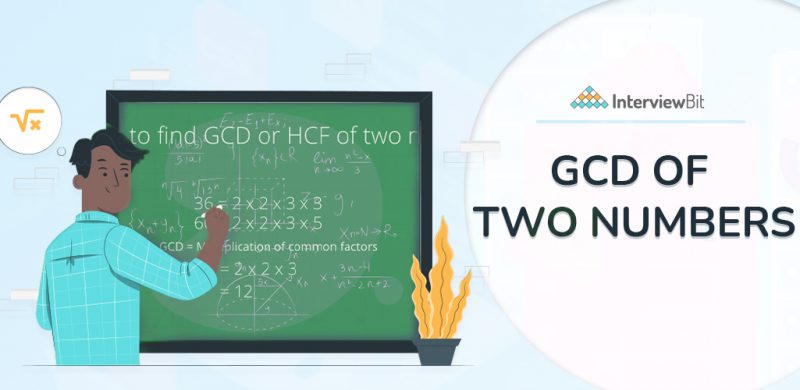Problem Statement
Given two non-negative integers a and b, we have to find their GCD (greatest common divisor),i.e. the largest number which is a divisor of both a and b. It’s commonly denoted by
gcd(a,b). Mathematically it is defined as

Example:
Input: a=32, b=20
Output: 4
Explanation: 4 is the largest factor that divides both of the numbers.
Confused about your next job?
Input: a=98, b=70
Output: 14
Explanation: 14 is the largest factor that divides both of the numbers.
Input: a=399, b=437
Output: 19
Explanation:

Simple Approach
We can traverse over all the numbers from min(A, B) to 1 and check if the current number divides both A and B or not. If it does, then it will be the GCD of A and B.
C++ Implementation
int GCD(int A, int B) {
int m = min(A, B), gcd;
for(int i = m; i > 0; --i)
if(A % i == 0 && B % i == 0) {
gcd = i;
return gcd;
}
}Python Implementation
def GCD_Loop( a, b):
if a > b: # define the if condition
temp = b
else:
temp = a
for i in range(1, temp + 1):
if (( a % i == 0) and (b % i == 0 )):
gcd = i
return gcd Java Implementation
class Main {
public static void main(String[] args) {
// find GCD between n1 and n2
int n1 = 81, n2 = 153;
// initially set to gcd
int gcd = 1;
for (int i = 1; i <= n1 && i <= n2; ++i) {
// check if i perfectly divides both n1 and n2
if (n1 % i == 0 && n2 % i == 0)
gcd = i;
}
System.out.println("GCD of " + n1 +" and " + n2 + " is " + gcd);
}
}Time complexity: O(min(A, B))
Space complexity: O(1)
Efficient Approach: Euclid’s Algorithm
The algorithm is based on the below facts.
- When we have to reduce a larger number then what we can do in a simple manner is just subtract small numbers from larger numbers and from this we can notice GCD will not change. Hence we can keep subtracting the larger of two numbers, we end up with the GCD.
- Now instead of doing subtraction, we can do one more thing i.e if we divide the smaller number, the algorithm stops when we find remainder 0.

C/C++ Implementation of Efficient Approach
// Function to return
// gcd of a and b
int gcd(int a, int b) {
if (a == 0)
return b;
return gcd(b % a, a);
}Java Implementation of Efficient Approach
import java.util.*;
import java.lang.*;
class Interviewbit {
// extended Euclidean Algorithm
public static int gcd(int a, int b) {
if (a == 0)
return b;
return gcd(b % a, a);
}
}Python Implementation of Efficient Approach
def gcd(a, b): if a == 0 : return b return gcd(b%a, a)
Time complexity: O(Log min(a, b)) where ‘a’ and ‘b’ are two numbers.
Space complexity: O(1)
Practice Questions
- Solve Problem: Greatest Common Divisor
- Largest Coprime Divisor
- GCD CMPL
Frequently Asked Questions
Q1: How do you find the GCD of two numbers?
Ans: From the Euclidean algorithm as it has less time complexity (log(min(a,b))
Q2: Can we find the GCD of negative numbers?
Ans: Yes, GCD(6, -12) = GCD(-6, 12) = GCD(-6, -12) = GCD(6, 12) = 6.
Q3: Do any two positive integers always have a GCD?
Ans: Yes, as it’s the largest factor dividing both numbers.




